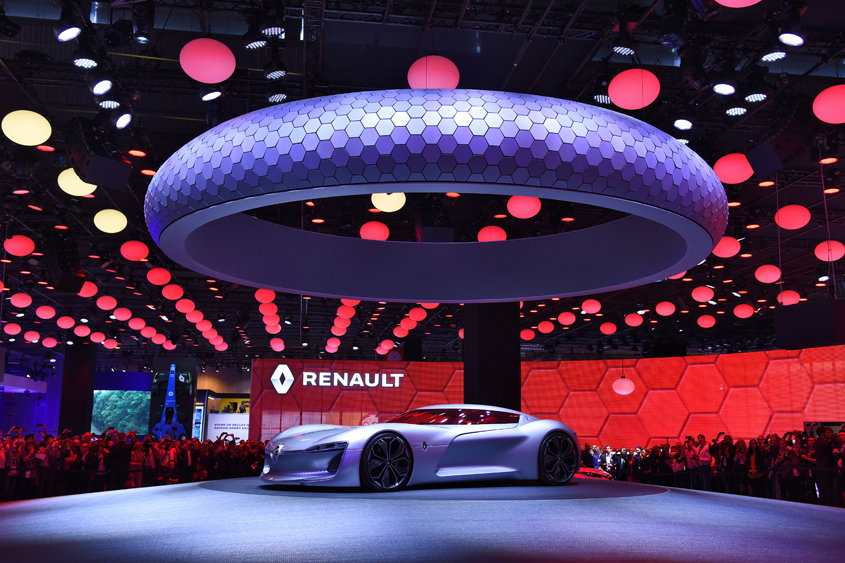Audi Q5 / Rs3
We start with A for Audi had two world premieres at the show. First was the unveiling of the second generation of Audi’s top-selling SUV, the Q5 while in the in the compact category, the German car maker’s sporty RS 3 Sedan made its debut in Paris.
The RS 3 can easily be termed as the most dynamic model of the A3 range. With a 400 hp five-cylinder engine, groundbreaking efficiency and an even sharper look, it is the first compact Audi sedan to bear the RS label. That makes it the most powerful five-cylinder engine on the world market. The compact RS model sprints from 0 to 100 km/h in just 4.1 seconds. It can attain a maximum speed of 250 km/h and on request Audi will increase the electronically limited top speed to 280 km/h.
The new Q5 is approximately 90kg lighter than the model it replaces, but is also bigger inside and out. The new car also gets Audi’s Virtual Cockpit display in place of more conventional dials. Initially, the Q5 will only be available with a 2-litre four-cylinder diesel engine that produces 187bhp, 12bhp more than the old Q5 with the equivalent engine. Not long after launch the Q5 will get a 249bhp 2-litre petrol engine and a 3-litre V6 diesel with 282bhp. All the engines will be turbocharged. Two gearboxes will be available, a six-speed manual and a seven-speed dual-clutch automatic.
Nissan Micra
Japanese car maker Nissan unveiled the 5th generation of its popular hatch the Micra in Paris. It has an all-new exterior and interior design, shares nothing from its predecessor. The car that has been in production for around three decades managed to impress one and all with its modern and attractive design. Design cues include the distinctive V-motion grille, which makes the car look more like a part of the Nissan family, boomerang-shaped lights, and the floating roof that creates an airy feeling. The new Micra will be available with two engine options for the time being, Petrol will be 0.9-liter turbocharged three-cylinder motor and the famed a 1.5-liter diesel engine, both of them delivering the same power output of 90 bhp.
The car is big on tech as well, and includes features like Lane Departure Prevention, Intelligent Emergency Braking with pedestrian recognition, High Beam Assist and Blind Spot Warning making them a part of Nissan Intelligent Mobility program.

Volkswagen I.D.
Global auto giant Volkswagen is embarked on a journey into the future at the Paris Motor Show with the world premiere of the visionary I.D. concept. The unique looking set of wheels is a highly automated electric car that will cover a distance of 400 to 600 kms on a single battery charge. The production version of the I.D. is due to be launched in 2020 at a very competitive price, but Volkswagen is looking even further ahead with this concept car. In “I.D. Pilot” mode, the electric car is capable of fully automated driving – this technology should be ready for series production in 2025. Volkswagen has also set itself the goal of selling a million electric cars a year by 2025; the production version of the I.D. will make a decisive contribution towards this in the ramp-up of e-mobility.
According to the company the electric power train has given the designers far greater freedom. The cooling grilles have been shrunk to a minimum, the axles have shifted far outwards and this has resulted in some breathtaking proportions. Ample space, maximum precision, a charismatic front end, iconic C-pillars, flowing, sculpted surfaces and expressive wheels are just a few of the design criteria of Volkswagen’s electro-mobility.
Renault Trezor
One of the concepts that’s grabbing a lot of eyeballs at Paris is the Renault Trezor which is an all-electric, two-seater car with autonomous driving capabilities. The car’s hallmark is its roof, which lifts up and is the only access to get inside the car. The Trezor displays silhouettes of grand tourer which include a long bonnet and a two-seater cabin with coupé like roofline and large footprints.
The car puts out a maximum power of 350 PS and a peak torque of 380Nm, and takes just 4 seconds to go from 0 to 100 kmph. Two battery packs are located separately, one at the front and the other at the rear, each of which has its own cooling system optimized by the variable-geometry air intake incorporated in the bonnet. The car also incorporates a brake-operated energy recovery system.
Ferrari GTC4 Lusso T
Finally, following on from the success of GTC4Lusso, which raised the performance bar for Ferrari’s traditional four-seater V12 GTs, the Prancing Horse announced the arrival of the new GTC4Lusso T, the first four-seater to be powered by a V8 engine. Ferrari says the car is aimed at drivers seeking a car that is sporty and versatile, as well as perfect for driving on a daily basis. It’s equipped with an evolution of the 3.9-litre V8 turbo which punches out a maximum of 610 bhp at 7,500 rpm, guaranteeing powerful acceleration with maximum torque of 760 Nm available between 3,000 and 5,250 rpm.
Designed by Ferrari’s Styling Centre, the GTC4Lusso T maintains the same innovative take on the shooting brake coupé as the V12 version, reinterpreting the concept with an extremely streamlined, tapered shape that gives it an almost fastback-like silhouette. The cabin is an effortless melding of sophisticated elegance – seen in the artisan quality of the prestigious hides – and the high-tech, sporty aspect of the metal or carbon-fibre components mainly found in the human-machine interfaces.
Shams Naqvi is an anchor/producer for the News X motor show Living Cars

